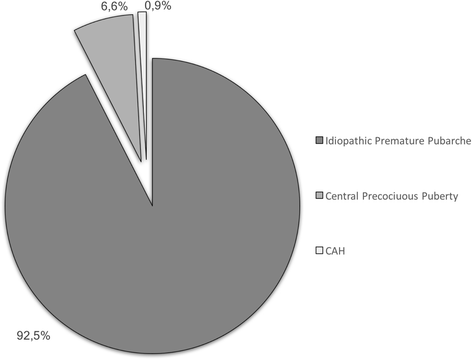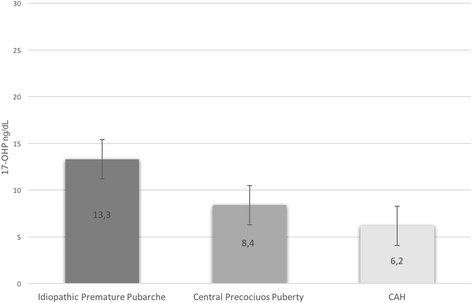Children with premature pubarche: is an alterated neonatal 17-Ohp screening test a predictive factor?
- PMID: 29338783
- PMCID: PMC5771218
- DOI: 10.1186/s13052-018-0444-6
Children with premature pubarche: is an alterated neonatal 17-Ohp screening test a predictive factor?
Abstract
Background: Neonatal screening for 21 hydroxylase deficiency is designed to detect classical form of congenital adrenal hyperplasia (CAH). It is still unclear whether newborns who result false positives at neonatal screening might later develop signs of androgen excess. The aim of this study is to verify whether a slightly elevated 17-OHP at newborn screening is a predictive factor for premature pubarche.
Methods: We evaluated all infants born between 2001 and 2014 with premature pubarche. In case of increased bone age, they were submitted to functional tests to find out the cause of their symptoms. Their 17-OHP values at newborn screening for CAH were reconsidered.
Results: We identified 330 patients (269 females, 61 males) with premature pubarche. All these children had a normal 17-OHP at newborn screening with the exception of a child, born preterm and not affected by CAH.
Conclusions: An elevated 17-OHP at newborn screening is not a predictive factor for premature pubarche. A likely cause of increased 17-OHP level at screening is an immaturity of adrenal gland or a neonatal stress. Therefore a strict follow up of these neonates during childhood is not necessary.
Keywords: 17-Ohp; Congenital adrenal hyperplasia; Newborn screening; Premature pubarche.
Conflict of interest statement
Ethics approval and consent to participate
The study was conducted in compliance with the terms of the Helsinki II Declaration. In Italy, this type of clinical study does not require Institutional Review Board/Institutional Ethics Committee approval to publish the results. Written informed consent was obtained from the parents of each patient.
Consent for publication
The authors have obtained consent to publish from the parents of all the patients.
Competing interests
The authors declare that there are no competing interests that could be perceived as prejudicing the impartiality of the affirmation reported.
Publisher’s Note
Springer Nature remains neutral with regard to jurisdictional claims in published maps and institutional affiliations.
Figures
Similar articles
-
Neonatal screening for congenital adrenal hyperplasia in Southern Brazil: a population based study with 108,409 infants.BMC Pediatr. 2017 Jan 17;17(1):22. doi: 10.1186/s12887-016-0772-x. BMC Pediatr. 2017. PMID: 28095810 Free PMC article.
-
Neonatal screening for congenital adrenal hyperplasia: 17-hydroxyprogesterone levels and CYP21 genotypes in preterm infants.Pediatrics. 2001 Oct;108(4):E68. doi: 10.1542/peds.108.4.e68. Pediatrics. 2001. PMID: 11581476
-
Transient hyper-17-hydroxyprogesteronemia: a clinical subgroup of patients diagnosed at neonatal screening for congenital adrenal hyperplasia.Eur J Endocrinol. 2009 Aug;161(2):285-92. doi: 10.1530/EJE-09-0145. Epub 2009 May 18. Eur J Endocrinol. 2009. PMID: 19451212
-
Current status of neonatal screening for congenital adrenal hyperplasia.Curr Opin Pediatr. 1997 Aug;9(4):419-23. doi: 10.1097/00008480-199708000-00018. Curr Opin Pediatr. 1997. PMID: 9300201 Review.
-
Recent advances in the diagnosis and management of congenital adrenal hyperplasia due to 21-hydroxylase deficiency.Hum Reprod Update. 2004 Nov-Dec;10(6):469-85. doi: 10.1093/humupd/dmh047. Hum Reprod Update. 2004. PMID: 15514016 Review.
Cited by
-
Endocrine Dysfunction in Children with Zika-Related Microcephaly Who Were Born during the 2015 Epidemic in the State of Pernambuco, Brazil.Viruses. 2020 Dec 22;13(1):1. doi: 10.3390/v13010001. Viruses. 2020. PMID: 33374895 Free PMC article.
-
Report on advances for pediatricians in 2018: allergy, cardiology, critical care, endocrinology, hereditary metabolic diseases, gastroenterology, infectious diseases, neonatology, nutrition, respiratory tract disorders and surgery.Ital J Pediatr. 2019 Oct 16;45(1):126. doi: 10.1186/s13052-019-0727-6. Ital J Pediatr. 2019. PMID: 31619283 Free PMC article. Review.
-
Newborn screening for congenital hypothyroidism, congenital adrenal hyperplasia and glucose-6-phosphate dehydrogenase deficiency in Bihar: A pressing priority in today's time.J Family Med Prim Care. 2023 Dec;12(12):3332-3338. doi: 10.4103/jfmpc.jfmpc_1029_23. Epub 2023 Dec 21. J Family Med Prim Care. 2023. PMID: 38361884 Free PMC article.
References
-
- Grosse SD, Van Vliet G. How many deaths can be prevented by newborn screening for congenital adrenal hyperplasia? Horm Res. 2007;67:284–291. - PubMed
MeSH terms
Supplementary concepts
LinkOut - more resources
Full Text Sources
Other Literature Sources
Medical



